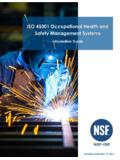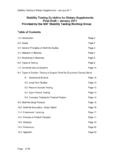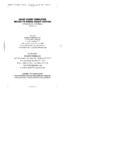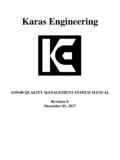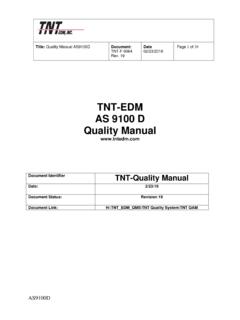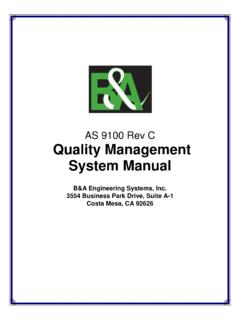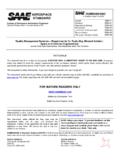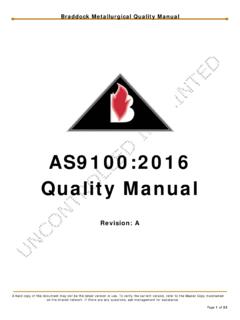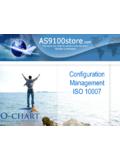Transcription of AS9100D Transition Guide
1 AS9100D Transition Guide Updated November 4, 2016 as9100 Series Overview as9100 Aerospace Management Systems is a widely adopted and standardized quality management system for the aerospace industry. It was introduced in October 1999 by the Society of Automotive Engineers in the Americas and the European Association of Aerospace Industries in Europe. The International Aerospace quality Group (IAQG) developed the as9100 document. as9100 encompasses ISO 9001, with additional requirements for quality and safety relevant to aerospace, and defines the quality management systems standard for the industry. All major aerospace manufacturers (OEMs) and suppliers worldwide endorse or require certification to as9100 as a condition of doing business with them.
2 AS9110 (Aerospace Management System for Maintenance, Repair and Overhaul (MRO) Stations) is based on as9100 and adds specific requirements that are significant for the maintenance of commercial, private and military aircraft. Certification of an MRO supplier to AS9110 is intended to provide an additional layer of control, but not act as a replacement for regulatory oversight or customer monitoring. AS9120 (Aerospace Management Systems for Stockist Distributors) is also based on as9100 and adds specific requirements for organizations that procure parts, materials and assemblies and sell these products in the aerospace industry ( stockist distributors). AS9120 addresses chain of custody, traceability, control and availability of records.
3 The standard is applicable to organizations that resell, distribute and warehouse parts found in aircraft and other aerospace components. The as9100 series International Aviation, Space and Defense quality Model has approximately 105 additional requirements beyond ISO 9001, including: - Configuration Management - Risk Management - Special Requirements - Critical Items - On Time Delivery - Project Management - Supplier Scope of Approval Key Benefits of as9100 The aircraft and aerospace industries have embraced as9100 as a critical tool for improving quality and on-time delivery within their supply chains. Most of the major aircraft engine manufacturers require as9100 certification for their suppliers.
4 Benefits of certification to as9100 global industry standards include: - A qualification to supply major aerospace manufacturers - Easy integration into existing quality management systems as the as9100 standard is based on ISO 9001, with additional, industry critical criteria - Access to the best practices of the aerospace industry for quality and traceability to help reduce operational risk - Enhanced marketability of your products and services through third-party proof of your commitment to deliver high- quality products and services - A focus on customer satisfaction: performance objectives must be aligned to customer expectations - Access to global markets through internationally recognized certification Reasons for Change All standards go through a regular update to bring them in line with industry changes and developments in technology.
5 The 9100 series (AS9110, AS9120 and AS9115) is being updated to: - Incorporate changes to the ISO 9001:2015 - Consider aviation, space and defense stakeholders needs (Web survey performed in 2013) - Incorporate clarifications to 9100 series requested by IAQG users since the last revision as9100 Areas of Focus Product Safety added in a separate clause and in selected areas Counterfeit Parts Prevention added in a separate clause and in selected areas Risk merged current 9100 requirements with the new ISO requirements and emphasis on risks in operational processes Configuration Management clarified and improved to address stakeholder needs Awareness reinforced requirements for awareness of individual contribution to quality Human Factors included as a consideration in nonconformity / corrective action Configuration Management clarified and
6 Improved to address stakeholder needs Product Realization and Planning clarified and enhanced planning throughout the standard Post-Delivery Support merged current 9100 requirements with the new ISO requirements Project Management combined with Operation Planning to address user interpretation issues Design Development and Supplier Management Gap analysis - ISO text has been added back in a few places to meet the IAQG needs quality Manual Note added pointing to the requirements that make up a quality manual or the equivalent Management Representative Requirement added back in for Management Representative QMS oversight Once as9100 :2016 Has Been What Should You Do?
7 Become Informed Become familiar with ISO 9001:2015 Purchase the as9100 :2016 standard and begin to understand it Understand differences between the 2016 version and previous versionsBegin Planning Customers have three years from the publication to Transition to the new standardCommunicate Communicate changes to your team, top management, organization and interested parties Questions, needs or suggestions? Contact NSF-ISR at Transition Timing for Industry & NSF Industry Date NSF Target Date Task 9/15/2015 ISO 9001:2015 Released 8/1/2016 Release of draft Supplemental Rule (SR003) 9/20/2016 AS9100D Release 10/20/2016 AS9101F Release 11/1/2016 AS9120B Release 11/4/2016 AS9110C Release 11/30/2016 AS9100D , AS9101F Auditor Training Released 12/1/2016 11/1/2016 Provide documented information on requirements of Transition to all certified clients 12/1/2016 11/15/2016 Communicate to AB (through OASIS) dates of readiness to upgrade scope to AS91XX.
8 16 12/3/2016 Next Gen OASIS Phase 1 1/1/2017 12/1/2016 Client establish Transition commitment date 1/16/2017 AS9110C, AS9120B Auditor Training Released 3/1/2017 2/15/2017 Obtain documented evidence of client's commitment to Transition to the upgraded version 4/22/2017 Next Gen OASIS Phase 2 6/15/2017 10/20/2016 CB Transition to 17021-1 complete 6/15/2017 2/1/2017 AS9104-001 accreditation updated to include 2016 version of AQMS standards including the 9101:2016 standard 6/15/2017 2/1/2017 Scope of accreditation must include 91XX:2016 criteria (9100, 9110, 9120, 9101) 6/15/2017 6/1/2017 All auditors transitioned and authenticated to new standards. 6/15/2017 6/15/2017 All audits conducted to new standards (may be exceptions for "special" audits) 9/1/2017 Current OASIS will no longer accept uploads Must be in Next Gen 9/15/2017 9/1/2017 CBs complete and report risk mitigation plan for un-transitioned certified clients 12/1/2017 11/15/2017 Conduct risk mitigation plan for any client that has not transitioned 1/1/2017 12/1/2016 Client establish Transition commitment date 9/15/2018 ISO 9001:2008 and AS Standards (AS9100C, AS9110B and AS9100A) Cancelled 9/15/2018 Transition complete - All non-transitioned certificates expire NSF-ISR suggests 2017 as target year for Transition to 9001.
9 2015 AS9100D (2016) High Level Milestones Current certificates will not be valid after the 3-year Transition period Existing as9100 standard series users encouraged to Transition early, transitions may occur at any point during cycle Must maintain valid current certificate until successfully issued AS9100D (2016) Certificate o All organizations must Transition by September 15, 2018 o Audits should be completed no later than June 15, 2018 (This will allow sufficient time for NCR closure, if needed) Transition Updates How Long Will My Audit Be? Durations is required to be increased for all audits, to ensure an effective review of the changes between current standard(s) and new standard(s) The amount of increase will depend on factors: o The type of audit (Re-certification vs.)
10 Surveillance) o Client specific risk factors o Client specific level of readiness (self-survey) o A simple survey (~10-15 questions) will be sent to all clients in November, to gather specific information about each organization. We NEED this information, so please complete the survey. When Can I Upgrade? For as9100 , we anticipate readiness by Q1 of 2017 and can facilitate audits to AS9100D or AS9100C. Through 15 June 2017, the client organization has the choice of standard used After 15 June 2017, all audits must be conducted to the new standard (except Special Audits , like scope expansion) For AS9110 and AS9120, readiness will be a little later, based on a delayed release of auditor training.




